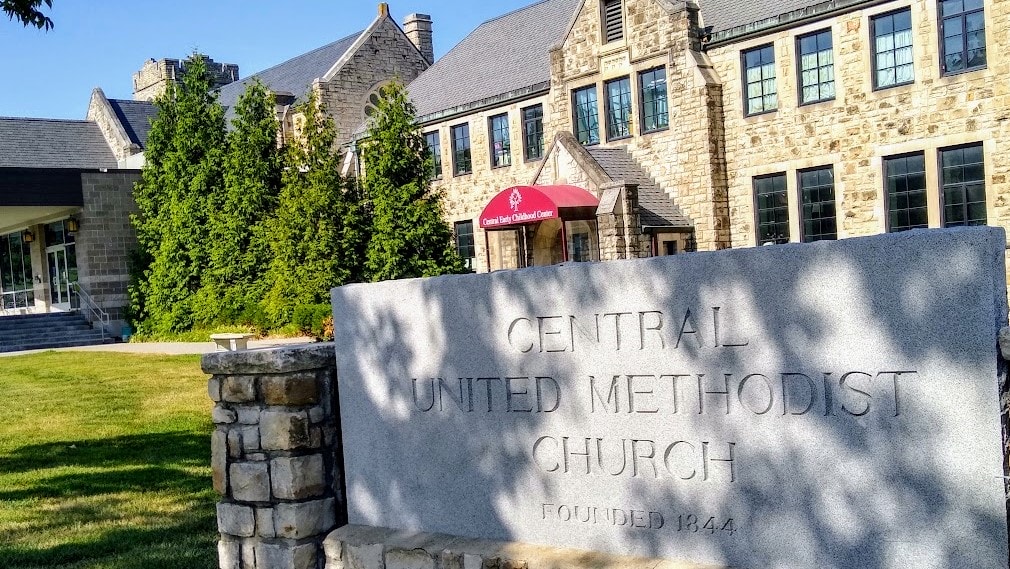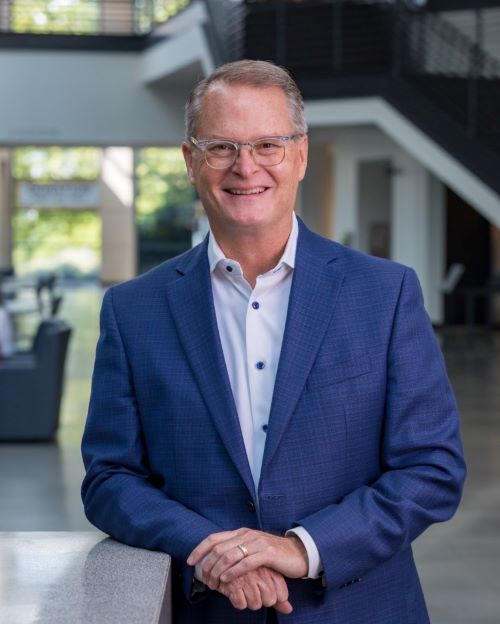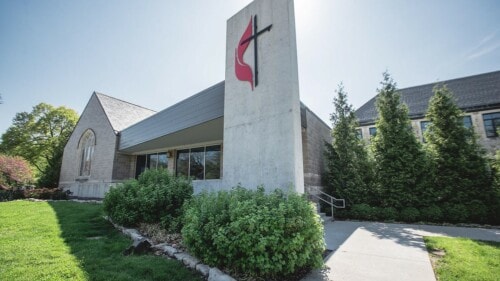Church of the Resurrection Confronts Uncertain Future Grappling With Methodist Schism
Published February 26th, 2023 at 6:00 AM
Above image credit: The historic Central United Methodist Church at 52nd and Oak in Kansas City became the sixth COR campus late in 2022. (Bill Tammeus | Flatland)The ground seems to be shifting under the strikingly successful United Methodist Church of the Resurrection (COR), which now has six campuses in the metro, including its primary one at 137th Street and Roe Boulevard in Leawood.
For starters, the mainline Protestant denomination that includes COR is experiencing a painful schism, essentially over what the Bible says, if anything, about homosexuality. COR is aligned with those who want the church to be welcoming to all, including the LGBTQ+ community.
But more than 2,000 churches already have left the denomination either to join the new, more theologically conservative Global Methodist Church (GMC) or to become independent congregations.
Exactly how the United Methodist Church will look in a year or two is uncertain, but it clearly will have even fewer congregations.
Next, COR’s founding pastor, the Rev. Adam Hamilton, who began the church in 1990 with a handful of members, will turn 60 next year and already is planning for his eventual retirement somewhere around age 65. How will COR’s 22,000 members react to a future without Hamilton’s appeal and leadership? No one knows.
Finally, COR has just added a sixth campus, Central United Methodist Church at 52nd and Oak streets, where Hamilton was an associate pastor at the start of his career. That congregation in recent years has experienced falling numbers at worship and dwindling membership. Early results under COR’s umbrella look promising, but it’s too early to tell what that congregation ultimately will look like.
“It’s kind of fun to see a historic church (it started in 1844) that has new life,” Hamilton says.

My friend Sally Firestone (we grew up on the same street in Woodstock, Illinois, and were two years apart in school) has been a member of Central for years. She is hopeful about her congregation being part of COR.
“It’s the best option for the future,” Firestone says. “We do have a legacy of renewing ourselves over the decades. And we’ve tried many things, so maybe this will give us more stability.”
Another Central friend, who asked not to be quoted by name, told me: “I look forward to a very vibrant church presence at that location for years to come. That said, the change has been hard for some, especially the old, venerable members of Central who simply can’t cope with the crowds, screens, introductions, registering attendance via cell phone, etc. Some of them feel as though they have been evicted from their church home, which is kind of heartbreaking.”
No doubt such pain is part of the price of gaining the possibility of any future.
As for the UMC schism, Hamilton has watched it unfolding with hope, heartache and, clearly, some anger.

“So, part of what’s been frustrating and painful is listening to the marketing and public relations from the new denomination (GMC) explain why people should leave (the UMC),” Hamilton says. “They say they’re not actually saying this, but what you hear — and I’ve had hundreds of emails from people across the country and messages on social media — is that the United Methodist Church no longer believes or will no longer believe in the Trinity. We’re not going to believe in the divinity of Jesus. We won’t believe in the resurrection.
“So that’s simply not true. It’s almost impossible to change our doctrines and I don’t know anybody who wants to. It’s really sad. I’ve told people that if the UMC decided not to believe any of these things anymore, I’d be the first one out. We’re simply not going to be a church that isn’t connected to the historic Christian faith. But we also recognize that we’re a church that makes room for doubts and questions.”
As this fight evolved — and as Hamilton correctly notes, “human sexuality is the real issue here” — he looked for ways to keep all sides in the same denomination. But that approach eventually failed.
The likelihood now is that COR will become an even more important voice in the smaller UMC, and thus will have to find ways to be a denominational leader without being so dominant that other voices can’t be heard. That will require tact and humility, both of which Hamilton has demonstrated throughout his career. Whether the COR pastoral leadership that will follow him will have those traits can’t yet be known.
The vision of COR that Hamilton had at the start is still the vision today.
“Our driving purpose here at Resurrection is to build a Christian community where nominally or non-religious people are becoming deeply committed Christians,” Hamilton says. “And the idea of a Christian community is people who care for one another. They worship together, they grow together. That is a huge part of what we do. We still have about two-thirds of the people who join who weren’t involved with a church anywhere else.
“Everything we do is about helping people know that there’s a loving God who knows them personally and cares about them and that, in our faith in Christ, we find hope, we find life, we find love, we find meaning and it changes who we are and how we live. That for us has continued to be a driving passion.”

This approach does not emphasize just belief but also putting belief into action.
“Deeply committed Christians,” he says, “love God with their head, their intellect, their heart and their hands. It’s not enough to have a ‘personal relationship with Jesus.’ It’s helping people have a deep faith that’s connected to Christ very personally. But then our goal is to inspire or equip them to live out that faith in the world.”
Which leads him to exclaim this: “I’m more excited today than I probably have ever been as pastor of the Church of the Resurrection.”
The decline of Mainline Protestant churches has been a story for decades, and Hamilton thinks he knows what’s gone wrong: “Mainline churches faltered when we forgot that we needed to convince people that they needed to invite friends to church. We lost our passion.”
Well, there’s no single answer to explain this diminishment of such churches or the falling popularity of religion generally in a nation in which almost 30% of the adult population now identifies as religiously unaffiliated.
But scholars studying this trend point to various ways in which the idea of transcendence has been screened out of life in this post-modern era, which is increasingly dismissive of any answers that science can’t prove.
COR’s story seems to refute all of that. Hamilton readily acknowledges that in his early days at COR, he studied business and leadership techniques because he says he didn’t get much of that in seminary. But, in the long run, he says: “You can’t business-leadership your way out of decline in churches. There are some business principles that just don’t translate into the church world — and shouldn’t.”
“Our driving purpose here at Resurrection is to build a Christian community where nominally or non-religious people are becoming deeply committed Christians. And the idea of a Christian community is people who care for one another. They worship together, they grow together. That is a huge part of what we do.”
Adam Hamilton, founding pastor of the United Methodist Church of the Resurrection
So, he continues to focus on the transcendent, on a God who is a cosmic mystery. But he then asks COR’s members to consider the implications of being loved by a God who wants them, in turn, to love the wounded world.
“Our aim,” he says, “was to build a church that would be here hundreds of years from now. Part of the task is to figure out how we can be set up to be a multi-generational and, I hope, multi-century church. I know it will change when I’m gone — and it should.”
What COR will look like 10, 20 or 100 years after Hamilton leaves is unknowable. But every indication is that he has prepared it to face with courage whatever changes or crises may confront it. Will that be enough? Perhaps only God knows.
Bill Tammeus, an award-winning columnist formerly with The Kansas City Star, writes the “Faith Matters” blog for The Star’s website, book reviews for The National Catholic Reporter and for The Presbyterian Outlook. His latest book is Love, Loss and Endurance: A 9/11 Story of Resilience and Hope in an Age of Anxiety. Email him at wtammeus@gmail.com.




“human sexuality is the real issue here”
No. How the different parts of the church choose to treat LGBTQ+ folks is the issue. The LGBTQ+ folks and they exist in the world is not an issue.
Thank you for the indepth story on Church of the the Resurrection and the closing and reopening of the Historic Central UMC.
It is very informative and thought-provoking.
M